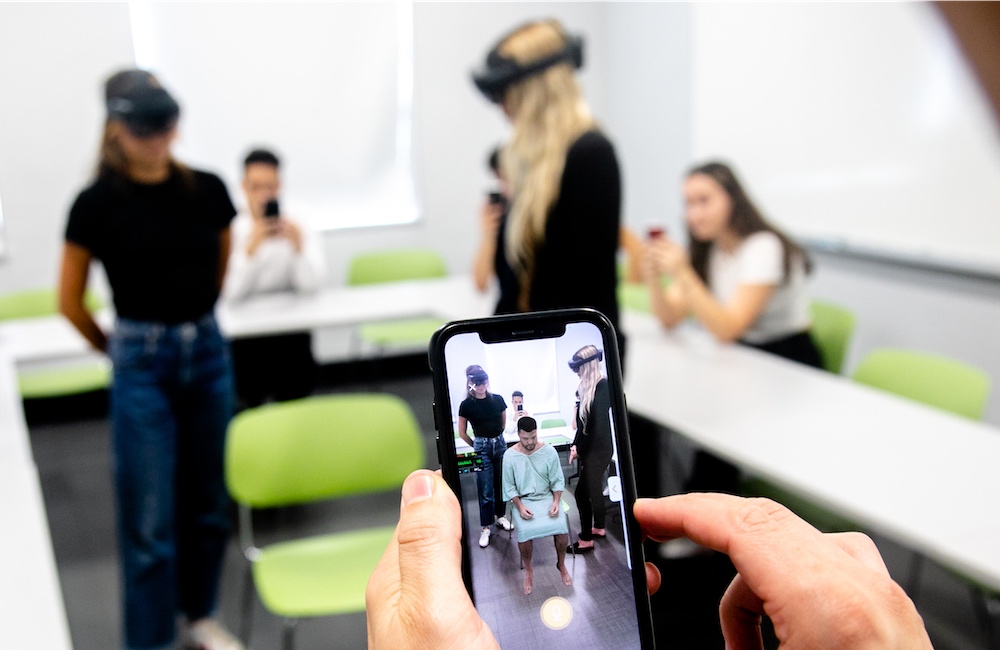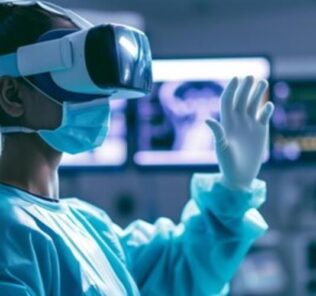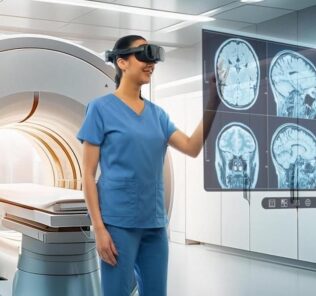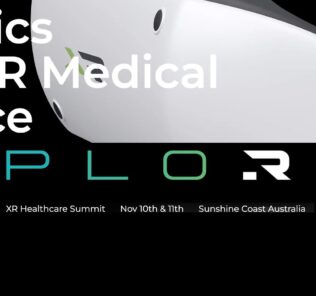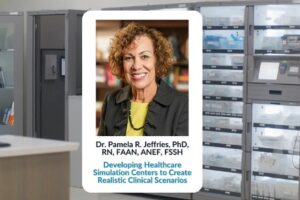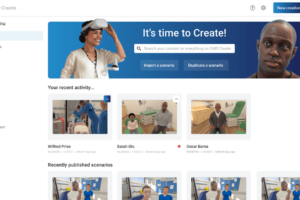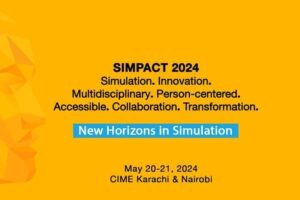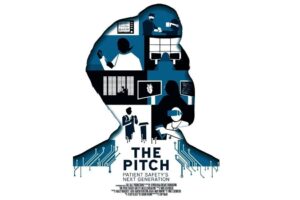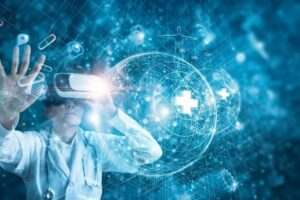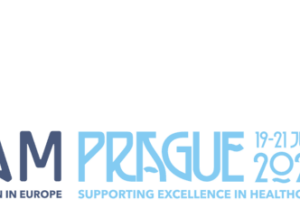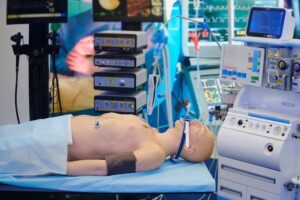Mixed Reality in Medical Education: Transforming Access to Healthcare Simulation Training
Healthcare professionals require the highest quality training to ensure outcomes are optimized. While they themselves have put their lives at risk to treat patients, the COVID-19 pandemic has added to the dangers and challenges presented by caring for the ill and injured. To better ensure that professionals, learners, and patients are all kept as safe as possible, healthcare simulation usage has skyrocketed since 2020. This article shares how and why clinical simulation has helped transform medical education and explains how the GIGXR platform has added to the realm of healthcare simulation’s educational possibilities.
Did you know that today most medical learners require a stipulated number of clinical simulation hours in order to graduate? Yet, traditional healthcare simulation techniques and tools, however, are unable to keep pace with gaining real-life skills to provide the best real-time treatment. Expensive, non-responsive manikins included in medical simulation centers come with significant overhead costs. Plus, standardized patient actors who pretend to be sick can’t evolve in real-time as the is illness treated. Additionally, healthcare simulation centers are limited, with social distancing and remote learning has become the “new norm.”
Now, more than ever, the industry requires new forms of training and the use of immersive technologies to make the best of healthcare simulation and evolve this practice to make training even more affordable, available, and – most importantly – effective.
Sponsored Content:
Doing just that, GigXR utilizes the power of mixed reality to enable healthcare learners and professionals to have the best possible preparation for patient care by providing holographic simulation, no matter where they are. Educators and learners can share sessions where they see the same holograms of standardized patients or the human anatomy layered into the real world. Benefits include that:
- The learner is no longer confined to the four walls of the simulation center in order to have a collaborative, immersive experience;
- The learner can run a simulation at any time from anywhere – even if they are sharing a healthcare simulation with those who are not in the same location. They can see see the same holograms at the same time;
- The learner will always see the real world, as hyper-realistic holograms are layered over their true environment as opposed to forcing you into a completely virtualized world to engage with video-game looking avatar patients;
- The learner can enter these simulations with your preferred device – whether a Microsoft HoloLens, smartphone, or tablet;
- The learner can improve realism by interacting with hyper-realistic holograms that they can see deteriorate or improve;
- The learner can minimize implicit bias and increase empathy by training with holographic standardized patients representing people of varying backgrounds.
GIGXR Makes implementing and operationalizing mixed reality easy so the learner or educator can receive all of the benefits listed above and more. Immersive training along with life-like content helps bridge the gap between theoretical learning and actual practice.
The GIGXR team approaches creating immersive learning from a 360-degree perspective. As educators, nursing specialists, 3D designers, technologists, and futurists, the team aims to push the boundaries of how mixed reality can support the global healthcare sector. Further, the company partners with luminaries from world-class institutions like Michigan Medicine, the University of Cambridge Hospitals, and Northwest Permanente P.C, each of whom understands the need to find innovative new solutions for simulation and who is among some of the leading mixed reality adopters in the field. By partnering with GigXR to develop content for our platform, these cutting-edge, elite institutions bring subject matter expertise and experience that drives the future of healthcare simulation and impact learning on a global scale.
“We use mixed reality to train future medical professionals so that they can feel more confident and prepared to provide patient care from day one,” said Mark Cohen, MD, Professor of Surgery, Pharmacology, and Biomedical Engineering at the University of Michigan. “An important goal of this novel mixed reality training and simulation development would be its ability to translate these skills acquired from hyper-fidelity real-world simulations into clinicians who are able to make diagnoses and perform procedures more efficiently with shorter durations and lower rates of error or complications leading to improved patient satisfaction and outcomes.”
Sponsored Content:
GIGXR’s products build on traditional simulation methods like the aforementioned healthcare simulation manikin and standardized patients. While these methodologies provide value in key aspects of patient care, they have limitations, especially in the representation of an evolving scenario: a manikin cannot show new wounds, or deterioration in a specific condition; standardized patients can only simulate the symptoms of a given pathology and students cannot use diagnostic tools such as stethoscopes, MRI scans or other tests to support their learning.
Mixed reality holographic content makes learning techniques and models limitless. For example, learners using mixed reality can overlay a hyper-realistic responsive patient over a manikin that can be instantly adjusted through parameters like gender, ethnicity, age, and body mass. The important tools required for diagnosis and treatment like x-rays and ultrasound scans can now all be simulated and customizable and broadcasted into any environment.
“Mixed reality revolutionizes how learners prepare for patient care in not only teaching medical skills and judgment but also enhancing communication skills with patients and other medical team members,” said Dr. Patricia Ramos, MD, MCRP, Medical Director, Center for Innovative Medical Simulation at KPNW, Senior Emergency Physician. “Bedside manners are a vital but underemphasized element of providing optimal patient care. Mixed reality allows us to practice intercommunication skills in ways that conventional training tools, like manikins, simply cannot.”
Join GigXR and Dr. Ramos for a deep dive into mixed reality and virtual reality to discuss when each is warranted in healthcare training: GIGXR believes that the hyper-realistic 3D models they use in their mixed reality products to create safe-to-fail environments in which medical and nursing learners can practice vital diagnostic, communication and clinical reasoning skills together, will ultimately become central to healthcare education. Mixed reality learning makes education more equitable, more inclusive of different learning styles and patient populations, and more thorough.
To that degree, the company has built features into the platform purposely designed to minimize friction in the delivery of mixed reality and to allow the sharing of best practices across the full industry. Users can configure and save a mixed reality setting to come back to in order to re-use in teaching settings. (Think of this as being similar to saving an MS Word file so the user does not need to rewrite the whole document from scratch every time!) These saved lessons, which we call Session Plans, can be shared across an institution or with all other institutions on the GigXR platform – allowing the learner or educator to both share and benefit from best practices.
Most importantly, perhaps, mixed reality helps learners to think like doctors and nurses long before they are in real clinical settings, something 2D theoretical models on book pages or static manikins simply cannot achieve. Mixed reality extends resources, curricula, accessibility, and possibilities – and it’s already happening. GigXRs growing catalog of first and third-party applications, and through its ongoing partnerships with esteemed teaching institutions, is setting new standards across the healthcare industry. The future of healthcare learning is here.
More About GIGR
GIGXR is a SaaS platform that delivers extended reality (XR) healthcare simulation applications for learning environments, higher education institutions, and enterprise facilities. The company offers an energetic training solution using Augmented Reality (AR) by creating innovative clinical simulation applications to solve perennial problems around visualization and 3D understanding.
Founded in 2019 and headquartered in Los Angeles, GIGXR has harnessed a proven track record for recognizing key problems in education and training and unlocking the potential of XR in simulation technologies to solve them. The company’s holographic applications and immersive learning platform have been built on years of pedagogical research. Adding to their credibility, they were developed by a team of experts and thought leaders in the fields of mixed reality learning, education technology, science, digital content, artificial intelligence (AI in simulation), and startup technology.
Within GIGXR’s first year of operation, the company acquired mixed reality and immersive learning assets from Pearson PLC, the largest education publisher in the world. This expansion was initiated so that GIGXR could include a growing catalog of healthcare and enterprise training applications in partnership with Microsoft under the brand name. The training applications they acquired can help to supplement curricula for some of the most prevalent and intractable learning and education challenges.
Learn More About the GIGXR Platform
Lance Baily, BA, EMT-B, is the Founder & CEO of HealthySimulation.com, which he started while serving as the Director of the Nevada System of Higher Education’s Clinical Simulation Center of Las Vegas back in 2010. Lance is also the Founder and acting Advisor to the Board of SimGHOSTS.org, the world’s only non-profit organization dedicated to supporting professionals operating healthcare simulation technologies. His co-edited Book: “Comprehensive Healthcare Simulation: Operations, Technology, and Innovative Practice” is cited as a key source for professional certification in the industry. Lance’s background also includes serving as a Simulation Technology Specialist for the LA Community College District, EMS fire fighting, Hollywood movie production, rescue diving, and global travel. He and his wife Abigail Baily, PhD live in Las Vegas, Nevada with their two amazing daughters.
Sponsored Content:



